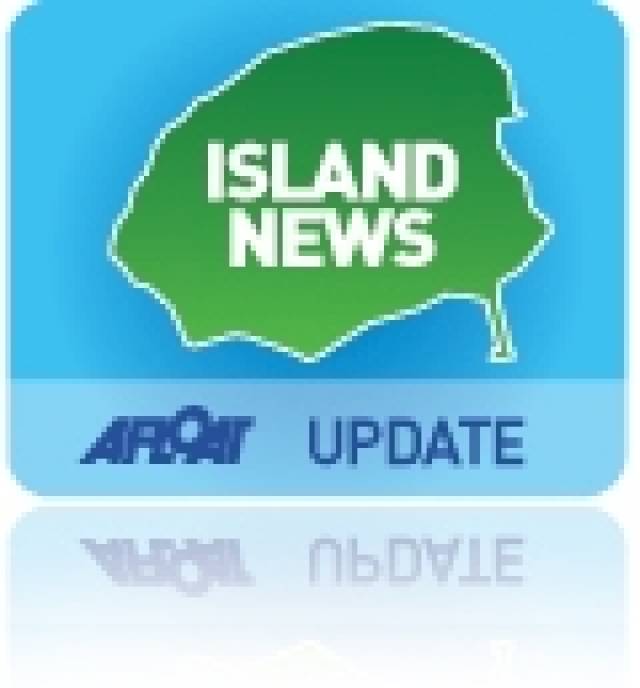#medieval – Two medieval carvings that mysteriously went missing from Scattery Island in the Shannon Estuary more than 150 years ago have been located and are to be returned to the island as part of a Gathering event next month.
According to the Scattery Island Heritage & Tourism Group the stone artefacts were removed from the former monastic settlement in County Clare by a sea captain during the mid-19th century.
Their location was only identified earlier this year when the Group was contacted by a local family who had the artefacts for safekeeping (*see Notes to Editor) having discovered them more than 50 years ago.
The artefacts have been verified professionally and dated to the 12th and early 15th centuries by medieval stone carvings expert Jim Higgins (Heritage Officer for Galway City Council) and Dr Catherine Swift, Director of Irish Studies at Mary Immaculate College in Limerick.
Rita McCarthy of the Scattery Island Heritage & Tourism Group said the carvings will be returned to the island on July 7th as part of the Scattery Island Gathering.
She explained: "We are very grateful to local man Padraig de Barra, who for many years has held the artefacts for safekeeping and is keen to see them returned to Scattery Island. We understand that the Captain of the 'Erin Go Bragh' passenger ship, Francis Kennedy removed the artefacts from the island and used them as garden ornaments at his home in Cunningham Terrace in Kilkee. Sometime after his death in 1865 the artefacts were brought to St Senan's Well in Kilfeeragh where they remained until the 1960s whence they were discovered by Padraig. However, the stone carvings were never returned to the island due to concerns for their security."
Scattery Island, which has been uninhabited since 1979, is located approximately one mile from Kilrush in the Shannon Estuary and is home to a monastery founded in the early 6th century by St. Senan. The island features the ruins of six churches and one of the highest Round Towers in Ireland at 120 ft. high. The Vikings invaded Scattery during the early 9th century but Brian Boru later recaptured the island, which is also known as Inis Cathaigh. Scattery also served as a place of safe harbour for the Spanish Armada and as a defence outpost for the English Government.
Commenting in the upcoming Gathering event and imminent return of the carvings to the island, Ms. McCarthy stated: "The unveiling of these artefacts will be the focal point of the weekend which will feature a range of events promoting one of Ireland's least known monastic settlements. We are inviting former island inhabitants and anyone with a connection with Scattery or indeed, its rich history to join us on the weekend of July 5-7th."
The Scattery Island Gathering begins on Friday 5th July with the opening of a photographic exhibition by Dr Bernadette Whelan of the University of Limerick's History Department, which is sponsoring the event. The exhibition will run for one week at Quay Mills in Kilrush.
The Gathering at Scattery will be officially launched on Saturday 6th July. The day also will feature a Historical Re-enactment by Crack'd Spoon Theatre, Guided Island Tours and a Kids Treasure Hunt. The day concludes with a lecture on Brian Boru and Scattery's Viking settlers by Dr. Cathy Swift of Mary Immaculate College and Leonore Fisher, who specialises in Irish medieval history.
On Sunday 7th July, there will be a welcome ceremony for 'old and new friends to Scattery' followed by the unveiling of the artefacts. Sunday will also feature a number of events showcasing Scattery's rich maritime history including Curragh racing and a Water Cannons display.
Monica Meehan, Gathering Clare coordinator congratulated Scattery Island Heritage & Tourism Group for their efforts in promoting "one of County Clare's most important heritage sites".
She continued: "This Gathering event will help to promote the island as a visitor destination in West Clare and will help to inform locals and visitors to the County of its rich and varied history. We are delighted to be able to support this Festival and we would urge anyone with an interest in or connection with the island to attend some of the events taking place next month."
The Scattery Island Gathering is one of almost 170 events and festivals coordinated by the County Clare Gathering Steering Committee during 2013. Other events scheduled to take place during the coming weeks include Welcoming Claire to Claire (23 June), The Online Academy of Irish Music Gathering (1 July), Beal Boru Ringfort Gathering (4 July) and the Kilkee Playwright Festival (12 July).






























































